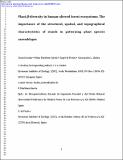Por favor, use este identificador para citar o enlazar a este item:
http://hdl.handle.net/10261/98437COMPARTIR / EXPORTAR:
 SHARE SHARE
 CORE
BASE CORE
BASE
|
|
| Visualizar otros formatos: MARC | Dublin Core | RDF | ORE | MODS | METS | DIDL | DATACITE | |

| Título: | Plant β-diversity in human-altered forest ecosystems: the importance of the structural, spatial, and topographical characteristics of stands in patterning plant species assemblages |
Autor: | Kouba, Yacine CSIC ORCID; Martínez-García, Felipe; Frutos Tena, Ángel de CSIC ORCID; Alados, Concepción L. CSIC ORCID | Palabras clave: | Secondary forests Community assembly Forest structure Compositional dissimilarity Beta diversity Species turnover |
Fecha de publicación: | 4-jun-2014 | Editor: | Springer Nature | Citación: | European Journal of Forest Research (on-line first): (2014) | Resumen: | [EN] An understanding of spatial patterns of plant species diversity and the factors that drive those patterns is critical for the development of appropriate biodiversity management in forest ecosystems. We studied the spatial organization of plant species in human-modified and managed oak forests (primarily, Quercus faginea) in the Central Pre-Pyrenees, Spain. To test whether plant community assemblages varied non-randomly across the spatial scales, we used multiplicative diversity partitioning based on a nested hierarchical design of three increasingly coarser spatial scales (transect, stand, region). To quantify the importance of the structural, spatial, and topographical characteristics of stands in patterning plant species assemblages and identify the determinants of plant diversity patterns, we used canonical ordination. We observed a high contribution of β-diversity to total γ-diversity and found β-diversity to be higher and α-diversity to be lower than expected by random distributions of individuals at different spatial scales. Results, however, partly depended on the weighting of rare and abundant species. Variables expressing the historical management intensities of the stand such as mean stand age, the abundance of the dominant tree species (Q. faginea), age structure of the stand, and stand size were the main factors that explained the compositional variation in plant communities. The results indicate that (1) the structural, spatial, and topographical characteristics of the forest stands have the greatest effect on diversity patterns, (2) forests in landscapes that have different land use histories are environmentally heterogeneous and, therefore, can experience high levels of compositional differentiation, even at local scales (e.g., within the same stand). Maintaining habitat heterogeneity at multiple spatial scales should be considered in the development of management plans for enhancing plant diversity and related functions in human-altered forests. | Descripción: | 37 páginas, 5 figuras, 2 apéndices. | Versión del editor: | http://dx.doi.org/10.1007/s10342-014-0822-6 | URI: | http://hdl.handle.net/10261/98437 | DOI: | 10.1007/s10342-014-0822-6 | ISSN: | 1612-4669 | E-ISSN: | 1612-4677 |
| Aparece en las colecciones: | (IPE) Artículos |
Ficheros en este ítem:
| Fichero | Descripción | Tamaño | Formato | |
|---|---|---|---|---|
| Kouba et al. Plant β-diversity in human-altered forest ecosystems_2014.pdf | 820,95 kB | Adobe PDF |  Visualizar/Abrir |
CORE Recommender
SCOPUSTM
Citations
15
checked on 16-abr-2024
WEB OF SCIENCETM
Citations
12
checked on 25-feb-2024
Page view(s)
328
checked on 18-abr-2024
Download(s)
295
checked on 18-abr-2024
Google ScholarTM
Check
Altmetric
Altmetric
NOTA: Los ítems de Digital.CSIC están protegidos por copyright, con todos los derechos reservados, a menos que se indique lo contrario.
